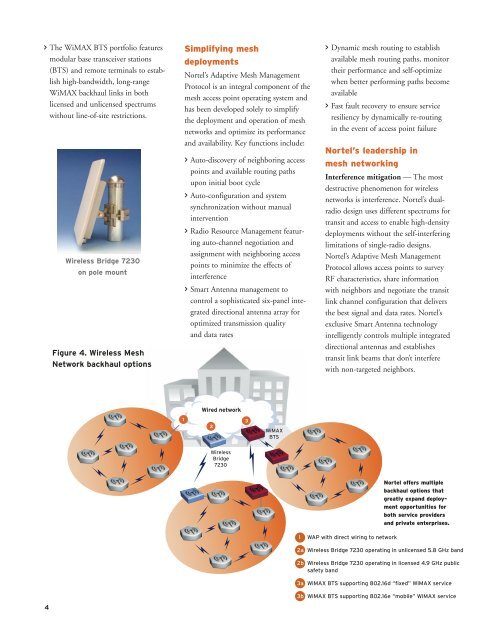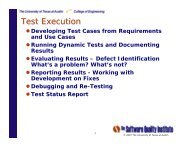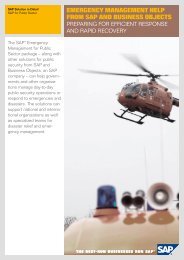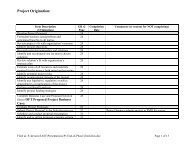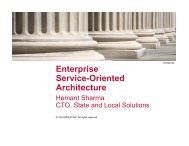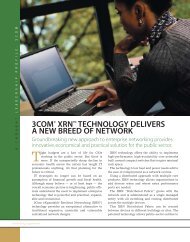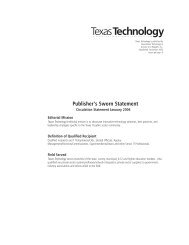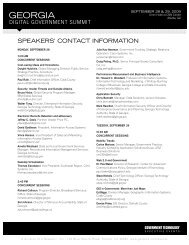Nortel Wireless Mesh Network - 1st Computer Networks
Nortel Wireless Mesh Network - 1st Computer Networks
Nortel Wireless Mesh Network - 1st Computer Networks
Create successful ePaper yourself
Turn your PDF publications into a flip-book with our unique Google optimized e-Paper software.
The WiMAX BTS portfolio features<br />
modular base transceiver stations<br />
(BTS) and remote terminals to establish<br />
high-bandwidth, long-range<br />
WiMAX backhaul links in both<br />
licensed and unlicensed spectrums<br />
without line-of-site restrictions.<br />
4<br />
<strong>Wireless</strong> Bridge 7230<br />
on pole mount<br />
Figure 4. <strong>Wireless</strong> <strong>Mesh</strong><br />
<strong>Network</strong> backhaul options<br />
Simplifying mesh<br />
deployments<br />
<strong>Nortel</strong>’s Adaptive <strong>Mesh</strong> Management<br />
Protocol is an integral component of the<br />
mesh access point operating system and<br />
has been developed solely to simplify<br />
the deployment and operation of mesh<br />
networks and optimize its performance<br />
and availability. Key functions include:<br />
> Auto-discovery of neighboring access<br />
points and available routing paths<br />
upon initial boot cycle<br />
> Auto-configuration and system<br />
synchronization without manual<br />
intervention<br />
> Radio Resource Management featuring<br />
auto-channel negotiation and<br />
assignment with neighboring access<br />
points to minimize the effects of<br />
interference<br />
> Smart Antenna management to<br />
control a sophisticated six-panel integrated<br />
directional antenna array for<br />
optimized transmission quality<br />
and data rates<br />
1<br />
Wired network<br />
2<br />
<strong>Wireless</strong><br />
Bridge<br />
7230<br />
3<br />
WiMAX<br />
BTS<br />
> Dynamic mesh routing to establish<br />
available mesh routing paths, monitor<br />
their performance and self-optimize<br />
when better performing paths become<br />
available<br />
> Fast fault recovery to ensure service<br />
resiliency by dynamically re-routing<br />
in the event of access point failure<br />
<strong>Nortel</strong>’s leadership in<br />
mesh networking<br />
Interference mitigation — The most<br />
destructive phenomenon for wireless<br />
networks is interference. <strong>Nortel</strong>’s dualradio<br />
design uses different spectrums for<br />
transit and access to enable high-density<br />
deployments without the self-interfering<br />
limitations of single-radio designs.<br />
<strong>Nortel</strong>’s Adaptive <strong>Mesh</strong> Management<br />
Protocol allows access points to survey<br />
RF characteristics, share information<br />
with neighbors and negotiate the transit<br />
link channel configuration that delivers<br />
the best signal and data rates. <strong>Nortel</strong>’s<br />
exclusive Smart Antenna technology<br />
intelligently controls multiple integrated<br />
directional antennas and establishes<br />
transit link beams that don’t interfere<br />
with non-targeted neighbors.<br />
1 WAP with direct wiring to network<br />
<strong>Nortel</strong> offers multiple<br />
backhaul options that<br />
greatly expand deployment<br />
opportunities for<br />
both service providers<br />
and private enterprises.<br />
2a <strong>Wireless</strong> Bridge 7230 operating in unlicensed 5.8 GHz band<br />
2b <strong>Wireless</strong> Bridge 7230 operating in licensed 4.9 GHz public<br />
safety band<br />
3a WiMAX BTS supporting 802.16d “fixed” WiMAX service<br />
3b WiMAX BTS supporting 802.16e “mobile” WiMAX service


